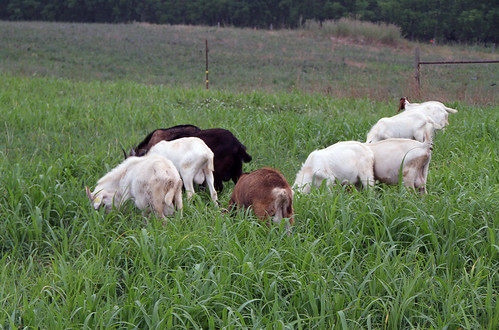By Jeff Semler
Forage management is always a challenge in pasture livestock production. Most of our pastures are cool season grasses in the East, and our goat test pastures are no exception.
Cool season grasses grow well during the spring and fall but shutdown during what is known as the "summer slump." We have used several different warm season annual grasses to fill in the gap. In addition to providing quality forage for the goats and because warm season annuals are tall, they reduce the opportunity for parasite infestation.
The first warm season annual we tried in our test pasture was dwarf pearl millet. This is a warm season annual, similar to sorghum sudans, with no prussic acid. Dry matter production is 20 percent less than sorghum sudans with better digestibility and protein.
It needs a soil temperature of 65ºF or more to germinate, and growth slows down when cool weather comes (September). Frost kills it, but it can still be grazed with no fear of prussic acid. It will also tolerate wetter years better than Sudan.
It needs good seed-to-soil contact and it’s not as competitive with existing grass as sorghum sudans. Like sorghum sudans, it can use lots of nitrogen.
The general recommendation is to start grazing at 12 inches and make sure the roots are not being pulled up. In addition it should not be allowed to grow taller than 3 feet (or it will lose palatability), nor grazed lower than 6 inches. This is not a concern when grazing goats but is a concern with cattle.
Wonderleaf, the variety we selected, will grow a little bushier than and not as tall as Sudan.
Last year we planted Summer Feast Mixture, a mix of Wonderleaf Millet and forage brassica. This summer annual mix will give you summer grazing with the brassica persisting into the fall even after frost. As with Wonderleaf alone there is no worry about prussic acid.
This year, we planted forage sorghum. This warm season annual is an excellent choice for marginal corn ground or as a double crop. It uses 30 to 50% less water than corn and less nitrogen too. The BMR trait has improved forage sorghums dramatically, and they are now considered an excellent dairy feed. Energy levels are comparable to corn and protein level is around 10 or 11%. Sugar levels are also very high.
We chose the variety Alfa AF7401 for our pastures. It is a gene 6 BMR dwarf forage sorghum with superior standability and great nutrition. We will be assessing the utility of this choice based on weight gain and fecal egg counts.
I have taken a forage sample and will share the results. While the sorghum cannot take all of the credit, the goats are growing better since they have been allowed access to these paddocks.
Stay tuned.
Forage management is always a challenge in pasture livestock production. Most of our pastures are cool season grasses in the East, and our goat test pastures are no exception.
Cool season grasses grow well during the spring and fall but shutdown during what is known as the "summer slump." We have used several different warm season annual grasses to fill in the gap. In addition to providing quality forage for the goats and because warm season annuals are tall, they reduce the opportunity for parasite infestation.
 |
| Bucks grazing dwarf pearl millet (2011). |
The first warm season annual we tried in our test pasture was dwarf pearl millet. This is a warm season annual, similar to sorghum sudans, with no prussic acid. Dry matter production is 20 percent less than sorghum sudans with better digestibility and protein.
It needs a soil temperature of 65ºF or more to germinate, and growth slows down when cool weather comes (September). Frost kills it, but it can still be grazed with no fear of prussic acid. It will also tolerate wetter years better than Sudan.
It needs good seed-to-soil contact and it’s not as competitive with existing grass as sorghum sudans. Like sorghum sudans, it can use lots of nitrogen.
The general recommendation is to start grazing at 12 inches and make sure the roots are not being pulled up. In addition it should not be allowed to grow taller than 3 feet (or it will lose palatability), nor grazed lower than 6 inches. This is not a concern when grazing goats but is a concern with cattle.
 |
| Bucks grazing Summer Feast Mixture (2012). |
Wonderleaf, the variety we selected, will grow a little bushier than and not as tall as Sudan.
Last year we planted Summer Feast Mixture, a mix of Wonderleaf Millet and forage brassica. This summer annual mix will give you summer grazing with the brassica persisting into the fall even after frost. As with Wonderleaf alone there is no worry about prussic acid.
This year, we planted forage sorghum. This warm season annual is an excellent choice for marginal corn ground or as a double crop. It uses 30 to 50% less water than corn and less nitrogen too. The BMR trait has improved forage sorghums dramatically, and they are now considered an excellent dairy feed. Energy levels are comparable to corn and protein level is around 10 or 11%. Sugar levels are also very high.
 |
| Buck grazing forage sorghum (2013). |
We chose the variety Alfa AF7401 for our pastures. It is a gene 6 BMR dwarf forage sorghum with superior standability and great nutrition. We will be assessing the utility of this choice based on weight gain and fecal egg counts.
I have taken a forage sample and will share the results. While the sorghum cannot take all of the credit, the goats are growing better since they have been allowed access to these paddocks.
Stay tuned.











